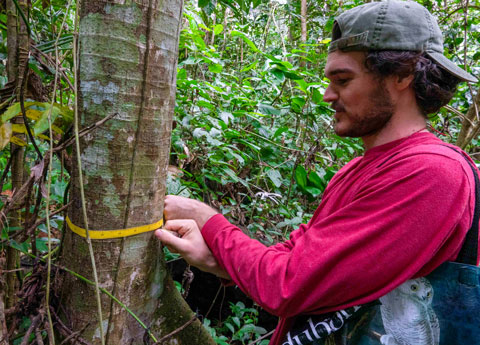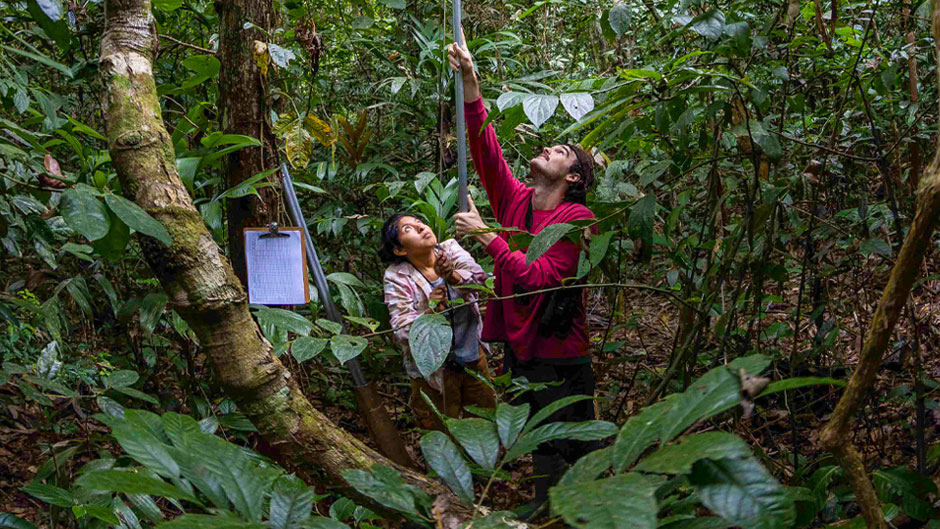This summer, graduate student Riley Fortier spent two months living at the field station Finca las Piedras in the Madre de Dios region of Southeastern Peru to study the trees along the western edge of the Amazon rainforest. Fortier is studying tropical forest ecology with the guidance of Kenneth Feeley, an associate professor of biology and researcher of tropical forests.
The remote field station is owned and operated by the nongovernmental organization Alliance for a Sustainable Amazon, and the nearest city is Puerto Maldonado, about an hour away by car. Fortier responded to questions and shared about his experience at the research and education center.
Tell us about the area where you were doing your research.
I am studying the trees in a lowland tropical rainforest in the Southwestern Peruvian Amazon. It receives about 6.5 feet of rainfall a year with an annual average temperature of 79 degrees. It is a "terra firme" [solid ground] forest, which means it doesn't ever flood. Unfortunately, many forests have been heavily logged in that area of Peru, so I want to know how that affects tree diversity and carbon storage in the surrounding areas that are still untouched.
Were you looking at a certain species on your trip? If so, why?

I am studying the terra firme tree community to learn about the species that are there and to monitor them over time—measuring growth, biodiversity, and carbon storage of the trees. Working with a collaborator from the Alliance for a Sustainable Amazon, this summer we set up the first one-hectare (about 2.47 acres) plot of many that we hope to survey and monitor in the region. In just one hectare of land, there are 180 species of trees (compare that to about 160 species in all of the Appalachian Mountains!). Although we were documenting all of them, one of the most important species in this forest is the Brazil nut tree (Bertholletia excelsa), which is one of the largest and longest living trees in the Amazon. It is an incredibly important part of the local economy because the nuts from the tree are exported all over the world. But you need intact forests to harvest a good crop of Brazil nuts because the trees are pollinated by bees only found in healthy forests.
Today, the Brazil nut tree is actually illegal to log in Peru because they want to keep them standing. But all the rest of the canopy trees are being logged to make flooring or furniture and everything in between.
How will studying these trees help us understand the natural world?
Studying the trees in this forest is important because it helps us understand the diversity and forest dynamics of the Amazon rainforest as a whole. This can be useful in understanding tropical forests in general, which are some of the most important ecosystems in the world for protecting biodiversity and storing carbon.
What specimens or data were you collecting?
I set up a permanent forest dynamics plot, which is an area of land that will be revisited through time. These plots are used by researchers to explain what’s going on in the forest. For example, they help us demonstrate the number of trees in a given hectare, the species that are prevalent, how fast they are growing, the rate that trees are dying, as well as how many new trees are sprouting up—they basically show the heartbeat of the forest. This year, I tagged and measured all of the trees greater than 10 centimeters diameter in one hectare and recorded their position within the plot, while also identifying each tree to its species using live leaf samples from its canopy. A few years from now, I will remeasure all of the trees and tag all of the new recruits that grow into the 10-centimeter-size class.
How is this useful?
The data I am collecting will be integrated into a large network of plots called RAINFOR, for the Amazon Forest Inventory Network. Because our plot is in an area that hasn't been sampled very heavily, this information will help fill a gap in the network. For example, just having a list of the tree species will help us better understand the plants and plant groups of the Southwestern Peruvian Amazon.
In addition, by measuring the growth and mortality of all of the trees in one hectare over time, we can estimate how much carbon is being sequestered and stored in the surrounding forest. Such data will help us understand the carbon dynamics of the entire Amazon rainforest.
What is the goal of your research?
By comparing the data with other plots in the region, I can learn about how the species composition and community dynamics change between terra firme and floodplain forests. These floodplain forests to the south of my plot surround the Madre de Dios River, which eventually flows into the Amazon River.
We also want to understand how the forest is being affected by logging that has accelerated in the region during the past 10 years. Our plot is located in a forest that has only recently been logged, but it is also surrounded by a human-managed landscape (there is Brazil nut harvesting, logging, and cattle farming throughout the region). I want to see whether our plot differs from plots in what is considered more pristine or untouched forest, and also from plots in even more disturbed forests.
Can this knowledge be applied to understand other ecosystems or fields of study?
Comparing forest dynamics on a global scale is becoming increasingly relevant. In the face of climate change, our knowledge of how the Amazon functions and how it differs from other forest types will help us predict how ecosystems will function in the future. In addition, knowing how a forest recovers from disturbance can help inform the management and conservation of tropical forests.

